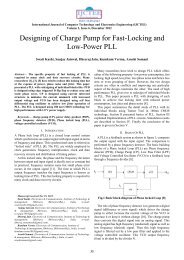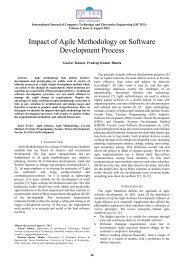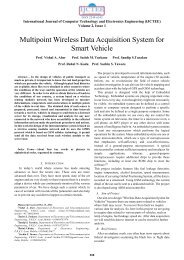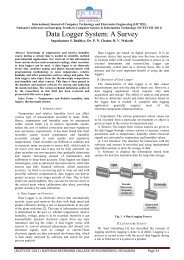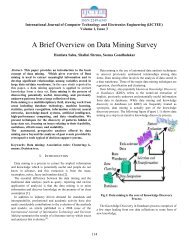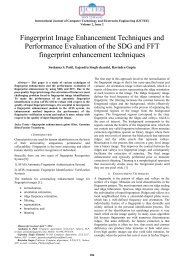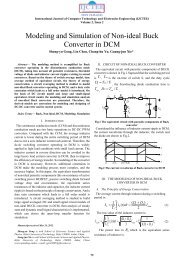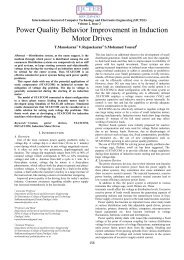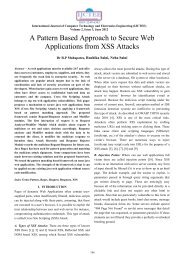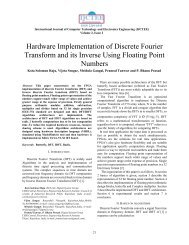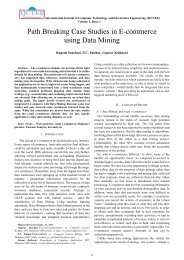Effect of Turbo Coding on OFDM Transmission to Improve BER
Effect of Turbo Coding on OFDM Transmission to Improve BER
Effect of Turbo Coding on OFDM Transmission to Improve BER
You also want an ePaper? Increase the reach of your titles
YUMPU automatically turns print PDFs into web optimized ePapers that Google loves.
for example, between a Reed Solom<strong>on</strong> outer code and a<br />
c<strong>on</strong>voluti<strong>on</strong>al inner code. The trellis decoding nature <str<strong>on</strong>g>of</str<strong>on</strong>g><br />
most c<strong>on</strong>voluti<strong>on</strong>al codes means that uncorrected errors at<br />
the output <str<strong>on</strong>g>of</str<strong>on</strong>g> the decoder will tend <strong>to</strong> occur in bursts. The<br />
interleaving between the two comp<strong>on</strong>ent codes then<br />
ensures that these bursts are adequately spread before<br />
entering the outer decoder. In both these examples, the<br />
interleaver is typically implemented as a block interleaver.<br />
This is a rectangular matrix such that bits or symbols are<br />
written in <strong>on</strong>e row at a time, and then read out <strong>on</strong>e column<br />
at a time. Thus bits or symbols which were adjacent <strong>on</strong><br />
writing are spaced apart by the number <str<strong>on</strong>g>of</str<strong>on</strong>g> rows when<br />
reading. The de-interleaving process is simply the inverse<br />
<str<strong>on</strong>g>of</str<strong>on</strong>g> this; writing in column by column and reading out row<br />
by row, <strong>to</strong> achieve the original bit or symbol ordering.<br />
Block interleaving is simple <strong>to</strong> implement, and suitable<br />
where the objective is <strong>to</strong> spread bursts <str<strong>on</strong>g>of</str<strong>on</strong>g> errors evenly by<br />
as large a distance as possible. Block interleavers are not<br />
suitable as turbo code interleavers, because they tend <strong>to</strong><br />
generate large numbers <str<strong>on</strong>g>of</str<strong>on</strong>g> codewords with a relatively low<br />
weight, and therefore with a relatively low hamming<br />
distance between them, due <strong>to</strong> the regularity <str<strong>on</strong>g>of</str<strong>on</strong>g> the<br />
spreading process. Berrou and Glavieux introduced<br />
pseudo-random interleaving in<strong>to</strong> turbo codes <strong>to</strong> solve this<br />
problem. A pseudo-random interleaver is a random<br />
mapping between input and output positi<strong>on</strong>s, generated by<br />
means <str<strong>on</strong>g>of</str<strong>on</strong>g> some form <str<strong>on</strong>g>of</str<strong>on</strong>g> pseudo-random number genera<strong>to</strong>r.<br />
Figure 3.6 shows a simple illustrati<strong>on</strong> <str<strong>on</strong>g>of</str<strong>on</strong>g> pseudo-random<br />
interleaving. The original data sequence is represented by<br />
the sequence <str<strong>on</strong>g>of</str<strong>on</strong>g> white squares, and the interleaved data<br />
sequence is represented by the grey squares. <str<strong>on</strong>g>Turbo</str<strong>on</strong>g> code<br />
<strong>BER</strong> performance improves with interleaver length - the so<br />
called interleaver gain - but the loading and unloading <str<strong>on</strong>g>of</str<strong>on</strong>g><br />
the interleaver adds a c<strong>on</strong>siderable delay <strong>to</strong> the decoding<br />
process. This would make a 256x256 interleaver unsuitable<br />
for, say, and real time speech applicati<strong>on</strong>s, which are delay<br />
sensitive.<br />
D. Puncturing<br />
Different code rates are achieved by puncturing the<br />
parity bit sequences and . Puncturing the data bit<br />
sequence leads <strong>to</strong> a severe degradati<strong>on</strong> in turbo code<br />
performance. Figure 3.4 illustrates the puncturing process.<br />
A number „1‟ in the tables represents a code bit that is<br />
included in the transmitted code bit sequence, and a<br />
number „0‟ represents a code bit that is excluded, or<br />
punctured. On the right <str<strong>on</strong>g>of</str<strong>on</strong>g> each table is the list <str<strong>on</strong>g>of</str<strong>on</strong>g> code bits<br />
which are included in the transmitted code sequence. In a),<br />
the code is unpunctured and is <str<strong>on</strong>g>of</str<strong>on</strong>g> code rate 1/3 whereas in<br />
b), alternate parity bits from each comp<strong>on</strong>ent encoder are<br />
punctured at each time interval k. The result is a rate 1/2<br />
codes. In c), the code is more heavily punctured, <strong>to</strong> form a<br />
rate codes 3/ 4[20].<br />
E. Terminati<strong>on</strong><br />
In c<strong>on</strong>trast <strong>to</strong> block codes, c<strong>on</strong>voluti<strong>on</strong>al codes do not<br />
have a fixed block length. C<strong>on</strong>voluti<strong>on</strong>al coding is a<br />
c<strong>on</strong>tinuous process, and could span an entire message,<br />
rather than a small group <str<strong>on</strong>g>of</str<strong>on</strong>g> bits. <str<strong>on</strong>g>Turbo</str<strong>on</strong>g> codes, however, do<br />
have a fixed block length, determined by the length <str<strong>on</strong>g>of</str<strong>on</strong>g> the<br />
interleaver. Tail bits are usually appended <strong>to</strong> each block <str<strong>on</strong>g>of</str<strong>on</strong>g><br />
data bits entering <strong>on</strong>e or other <str<strong>on</strong>g>of</str<strong>on</strong>g> the comp<strong>on</strong>ent encoders,<br />
<strong>to</strong> return it <strong>to</strong> the all-zeroes state at the end <str<strong>on</strong>g>of</str<strong>on</strong>g> the trellis.<br />
This process is called terminati<strong>on</strong>, and allows the MAP<br />
algorithm <strong>to</strong> make assumpti<strong>on</strong>s about the start and end<br />
trellis states. This yields better <strong>BER</strong> performance.<br />
Terminati<strong>on</strong> <str<strong>on</strong>g>of</str<strong>on</strong>g> both comp<strong>on</strong>ent encoders is more difficult,<br />
because the terminating sequence for the first encoder is<br />
interleaved and may well not, by itself, terminate the<br />
sec<strong>on</strong>d encoder. Interleaver designs have been devised [9]<br />
which interleave a terminating sequence in the first<br />
encoder in<strong>to</strong> a terminating sequence in the sec<strong>on</strong>d encoder.<br />
This tends <strong>to</strong> yield better <strong>BER</strong> performance than a single<br />
code terminating process and is another promising area for<br />
investigati<strong>on</strong>[20].<br />
(a) Rate 1/3 <str<strong>on</strong>g>Turbo</str<strong>on</strong>g> Code<br />
Figure 7. Pseudo- Random Interleaving in a <str<strong>on</strong>g>Turbo</str<strong>on</strong>g><br />
Encoder<br />
(b) Rate 1/2 <str<strong>on</strong>g>Turbo</str<strong>on</strong>g> Code<br />
Figure 8. Puncture Patterns for <str<strong>on</strong>g>Turbo</str<strong>on</strong>g> Codes<br />
98





